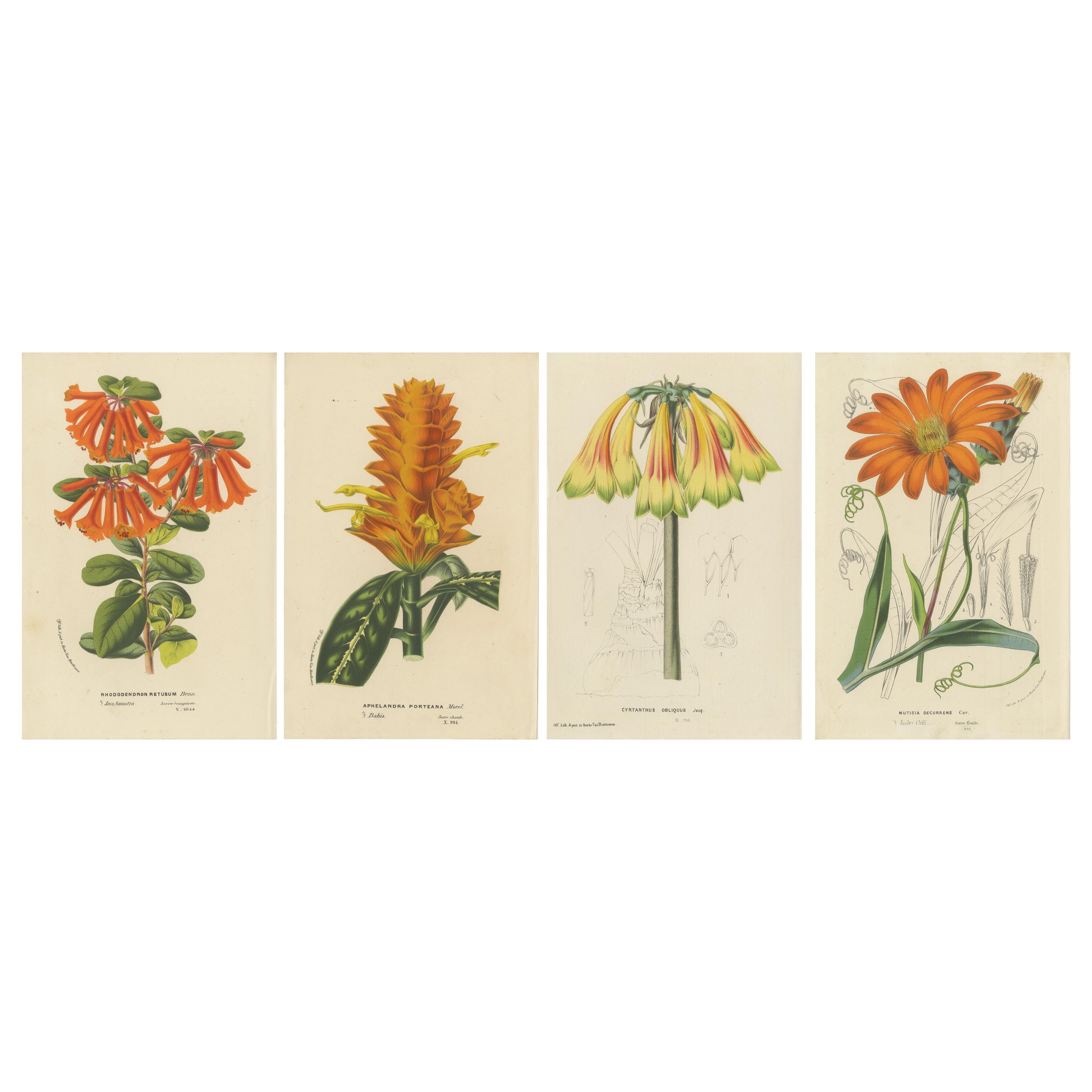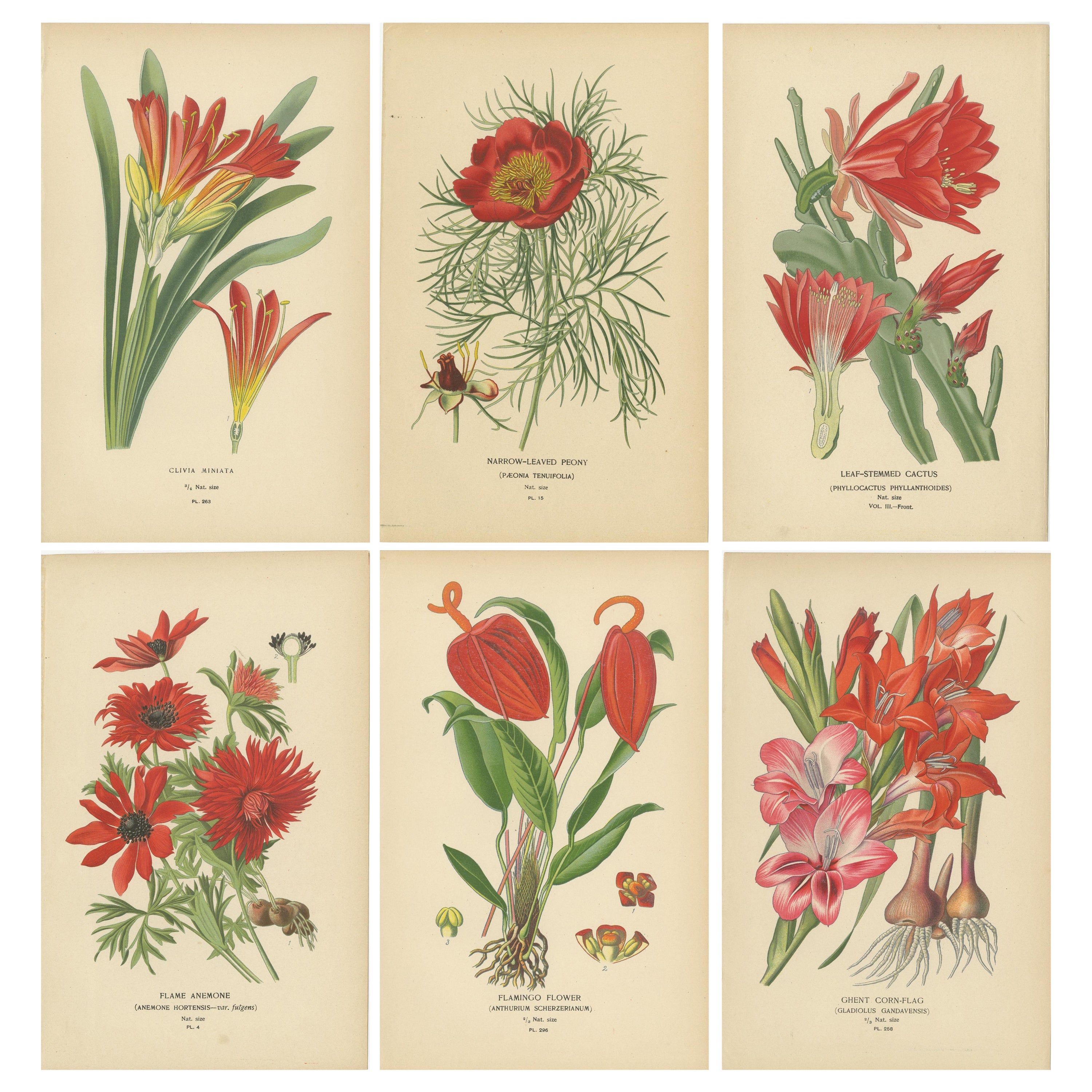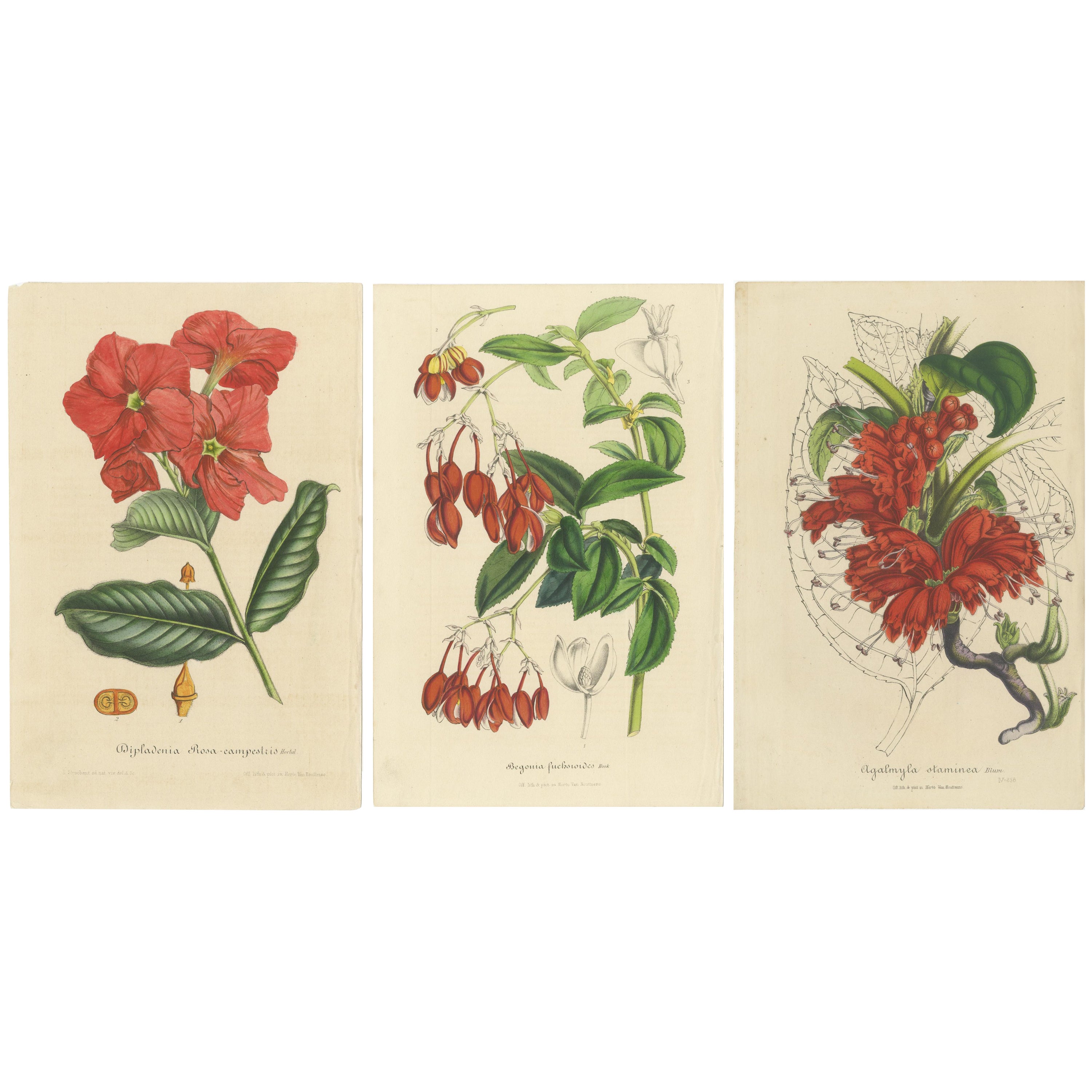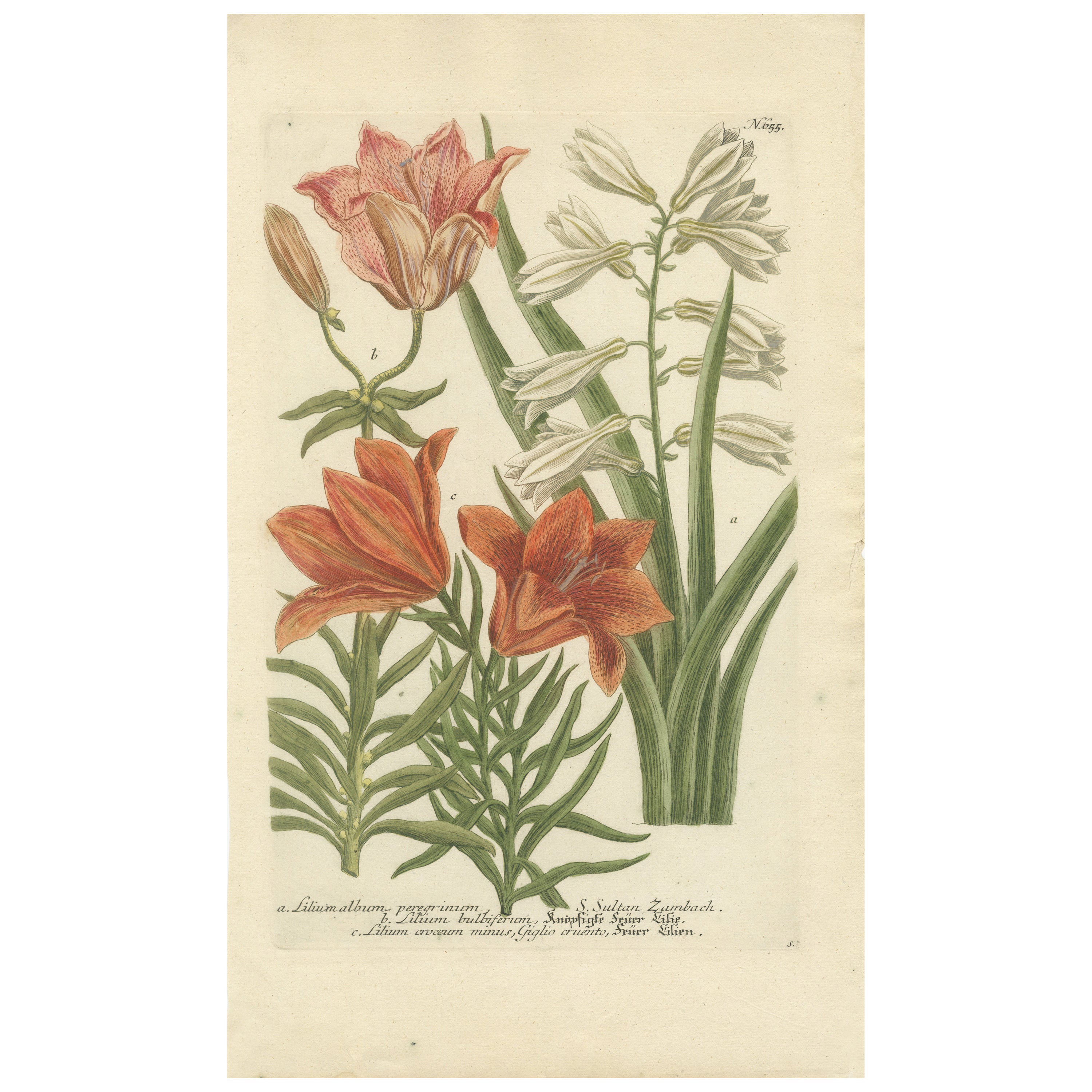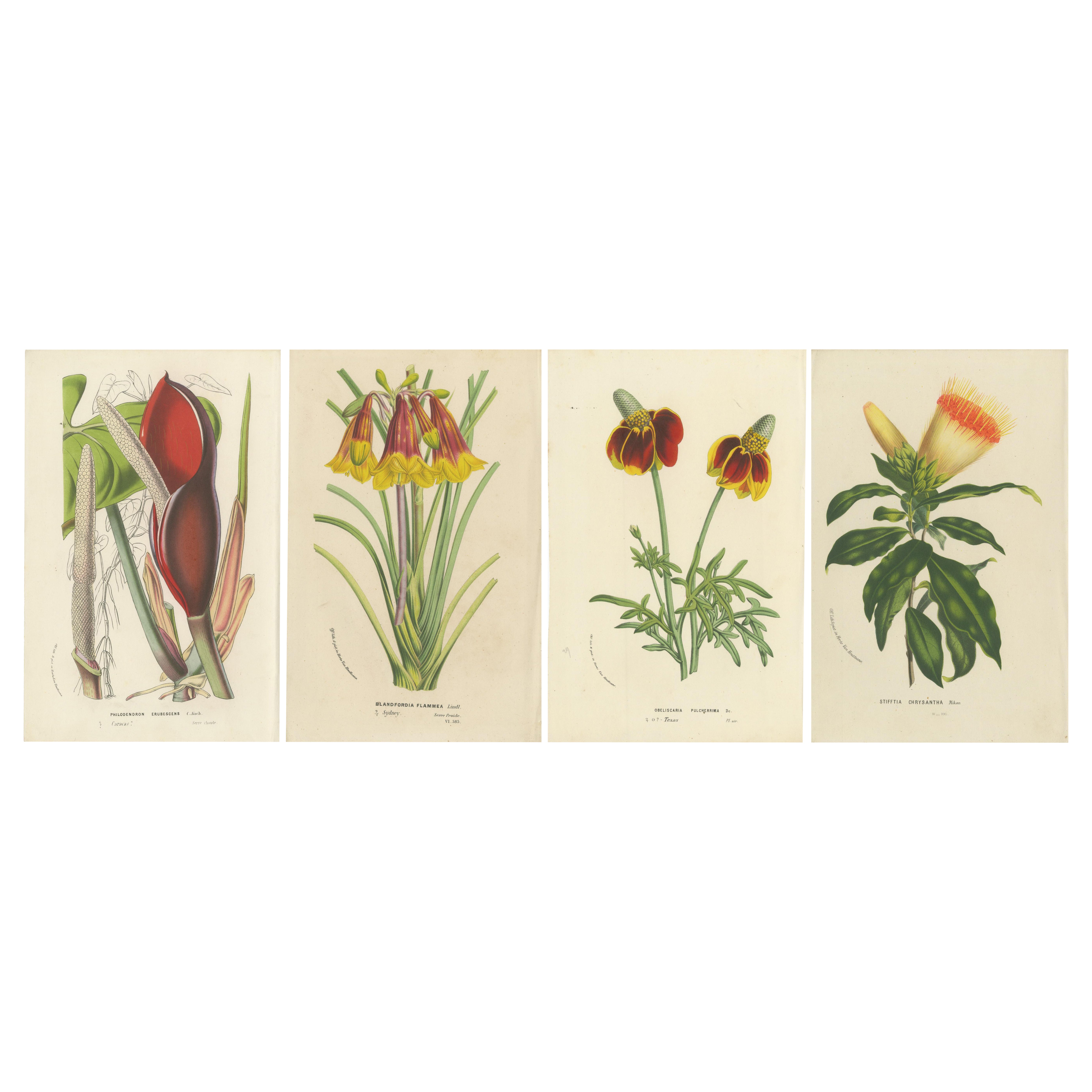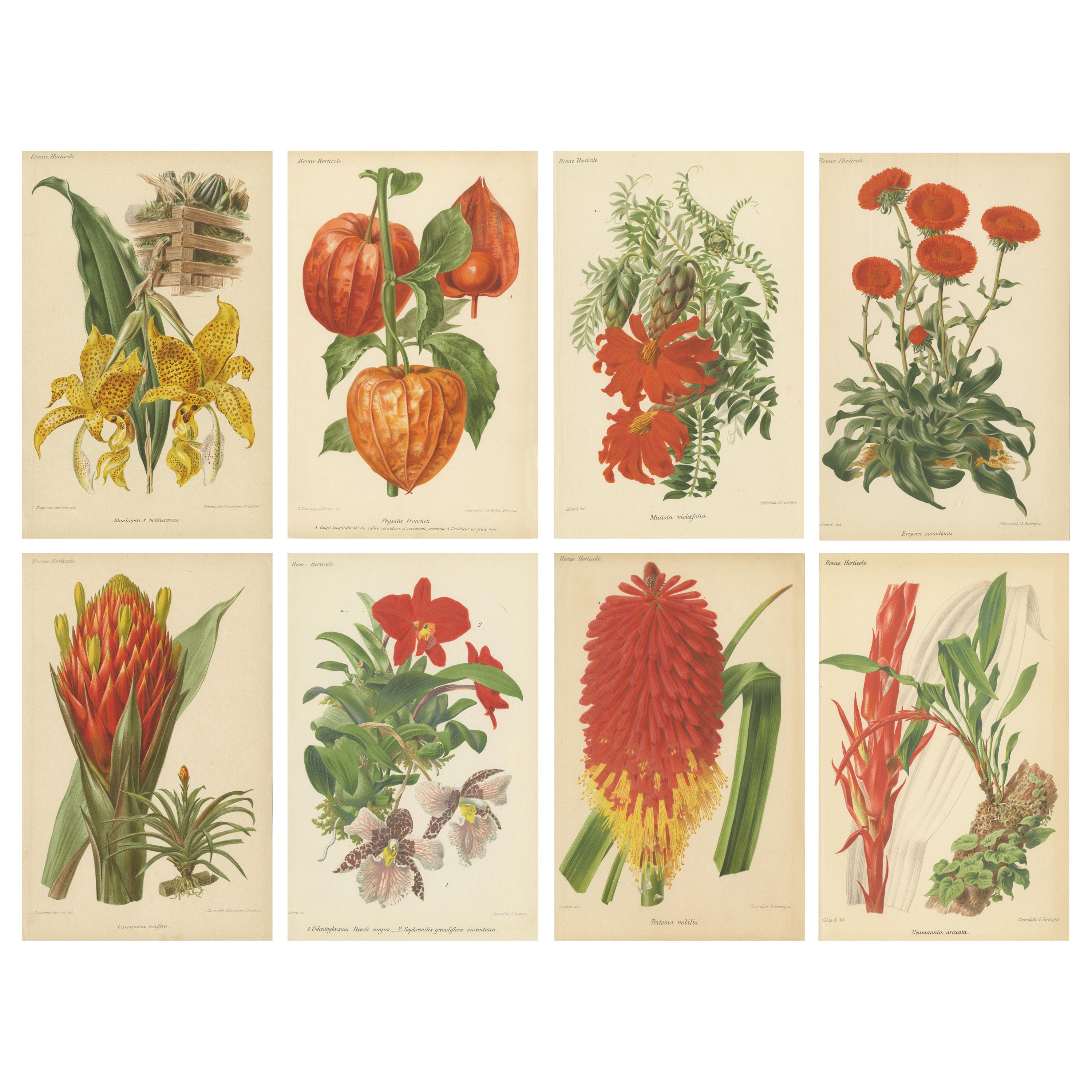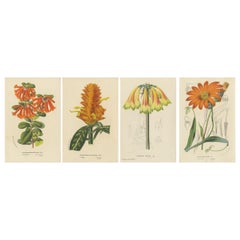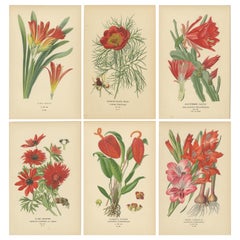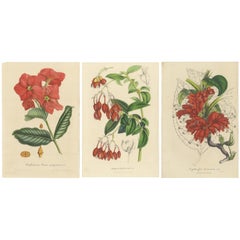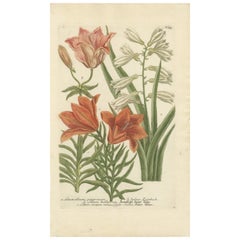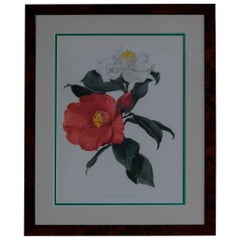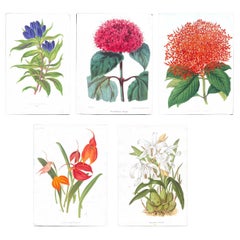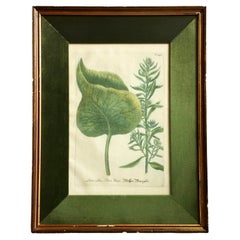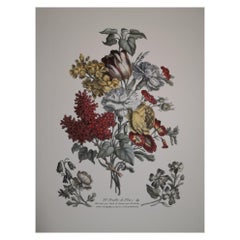Articles similaires à Fleurs enchantées : Chefs-d'œuvre de l'art botanique du Florilegium de Van Houtte
Vous voulez plus d'images ou de vidéos ?
Demander au vendeur plus d'images ou de vidéos
1 sur 7
Fleurs enchantées : Chefs-d'œuvre de l'art botanique du Florilegium de Van Houtte
112 €TVA incluse
140 €20 % de remise
À propos de cet article
La plante représentée dans l'estampe proposée est l'Azalea mollis 'Glabrior', une variété de l'espèce Rhododendron. Son nom commun en anglais est Smooth Azalea. Cette variété particulière se distingue par ses fleurs luxuriantes d'un orange vif qui peuvent parfois prendre une teinte rougeâtre, ce qui en fait un ajout saisissant à tout jardin.
Description et caractéristiques particulières :
- Nom botanique : Azalea mollis 'Glabrior' Regel var.
- Origine : Originaire du Japon, cette azalée est réputée pour sa croissance robuste et la présentation spectaculaire de grandes fleurs en forme de trompette qui s'épanouissent en grappes magnifiques. Les feuilles sont caduques et tombent en hiver, mais constituent une toile de fond verdoyante pendant la période de floraison.
- Description de la fleur : Les fleurs sont particulièrement remarquables pour leur taille, leur couleur vive et les délicates taches de rousseur sur les pétales, qui attirent les pollinisateurs et les admirateurs.
L'azalée lisse est célèbre non seulement pour son attrait esthétique, mais aussi pour son adaptabilité aux climats tempérés, ce qui en fait l'une des plantes préférées des jardiniers, tant pour les jardins privés que pour les expositions publiques. La capacité de la plante à produire une abondance de fleurs chaque printemps, associée à un entretien relativement facile, assure sa popularité dans les cercles horticoles. Sa couleur vibrante et sa floraison abondante sont souvent associées au renouveau printanier, symbolisant la paix et le rajeunissement, ce qui en fait un choix populaire pour de nombreux paysages culturels et festifs.
Contexte de l'estampe botanique :
Cette belle illustration botanique provient du *Flore des Serres et des Jardins de l'Europe* de Louis Van Houtte, ouvrage publié entre 1845 et 1883. Van Houtte, horticulteur et pépiniériste de premier plan, présentait des plantes comme cette azalée dans son catalogue, qui servait également d'exposition élaborée des espèces végétales les plus recherchées à l'époque. Les orchidées, les roses, les camélias et d'autres plantes exotiques étaient également mis en valeur, reflétant la fascination de l'ère victorienne pour les collections botaniques et la représentation luxuriante et vivante que permettait la chromolithographie.
Cette estampe n'est pas seulement un document historique sur les intérêts et les tendances horticoles du XIXe siècle, mais aussi une œuvre d'art qui capture la beauté et la diversité des plantes de jardin cultivées à l'époque de Van Houtte. L'état de l'estampe, telle que décrite, avec des marques mineures typiques de son âge, suggère qu'elle a été bien conservée, ce qui en fait une pièce de valeur pour les collectionneurs et les amateurs d'art botanique.
L'impression botanique de l'Azalea mollis 'Glabrior' provient de l'ouvrage de Louis Van Houtte, Flore des Serres et des Jardins de l'Europe, qui a été publié entre 1845 et 1883. Compte tenu du style et de la chromolithographie avancée utilisée dans l'estampe, il est probable qu'elle date de la fin de cette période. Par conséquent, une estimation approximative situerait la publication de cette estampe spécifique vers la fin des années 1870 ou le début des années 1880. Cette période correspondrait aux progrès technologiques et aux styles esthétiques représentés dans la gravure.
La technique utilisée pour l'impression botanique de l'Azalea mollis 'Glabrior' est la chromolithographie. Cette méthode était une forme révolutionnaire d'impression couleur du 19e siècle qui permettait des illustrations vibrantes et multicolores. La chromolithographie consiste à utiliser plusieurs pierres lithographiques, chacune encrée d'une couleur différente, pour produire l'impression finale. Chaque couleur nécessite une pierre distincte, et l'alignement méticuleux de ces pierres était crucial pour obtenir les résultats détaillés et vifs caractéristiques des illustrations botaniques de Louis Van Houtte. Cette technique permet des reproductions de haute qualité et artistiquement attrayantes d'œuvres botaniques originales, ce qui la rend très populaire pour l'illustration d'ouvrages prestigieux tels que *Flore des Serres et des Jardins de l'Europe*.
- Dimensions:Hauteur : 16,3 cm (6,42 po)Largeur : 25 cm (9,85 po)Profondeur : 0,02 mm (0 po)
- Matériaux et techniques:
- Période:
- Date de fabrication:Circa 1875
- État:Condit : Bon, compte tenu de l'âge. Tonalité générale liée à l'âge et/ou petits défauts occasionnels dus à la manipulation. Les couleurs sont vives, le bord est brunâtre, la bordure inférieure est coupée court. Veuillez étudier attentivement le scan.
- Adresse du vendeur:Langweer, NL
- Numéro de référence:Vendeur : BG-13761-121stDibs : LU3054341423772
À propos du vendeur
5,0
Vendeur reconnu
Ces vendeurs prestigieux sont des leaders du secteur. Ils représentent le summum en matière de qualité et de design.
Vendeur Platine
Vendeurs premium dont la note est supérieure à 4,7 et le délai de réponse de 24 heures maximum
Établi en 2009
Vendeur 1stDibs depuis 2017
2 609 ventes sur 1stDibs
Temps de réponse habituel : <1 heure
- ExpéditionRecherche du devis...Expédition depuis : Langweer, Pays-Bas
- Politique des retours
Certaines parties de cette page ont été traduites automatiquement. 1stDibs ne garantit pas l'exactitude des traductions. L'anglais est la langue par défaut de ce site web.
Garantie d'authenticité
Bien qu'il soit peu probable que la situation se présente, dans le cas où vous rencontreriez un problème d'authenticité d'un article, contactez-nous dans un délai d'un an pour obtenir un remboursement intégral. DétailsGarantie de remboursement
Si votre article n'est pas conforme à la description, est endommagé pendant le transport ou ne vous est pas livré, contactez-nous sous 7 jours pour obtenir un remboursement intégral. DétailsAnnulation sous 24 heures
Vous disposez d'un délai de 24 heures pour annuler votre achat sans motif.Des vendeurs professionnels agréés
Nos vendeurs de renommée mondiale doivent respecter des normes strictes en matière de service et de qualité, afin de préserver l'intégrité de nos fiches produit.Garantie d'alignement des prix
Si vous constatez qu'un autre vendeur a mis en vente le même article à un prix inférieur sur un autre site, nous nous alignerons sur ce prix.Livraison en toute confiance à l'international
Notre réseau de transporteurs de premier ordre propose des options d'expédition spécialisées dans le monde entier, y compris des livraisons personnalisées.Plus d'articles de ce vendeur
Tout afficherPortraits botaniques vibrants : exquises illustrations de plantes du 19e siècle
Ces illustrations, exécutées avec précision et richement colorées, sont de beaux exemples de chromolithographie, une technique populaire au 19e siècle pour sa capacité à produire des...
Catégorie
Antiquités, années 1870, Estampes
Matériaux
Papier
304 € Prix de vente / ensemble
20 % de remise
Illustrations botaniques de l'époque victorienne : Une Celebrity visuelle de la flore
Il s'agit de vibrantes chromolithographies extraites de "Favourite Flowers of Garden and Greenhouse" d'Edward Step, illustrées par Désiré Boi et publiées en 1896 par Frederick Warne ...
Catégorie
Antiquités, années 1870, Anglais, Estampes
Matériaux
Papier
392 € Prix de vente / ensemble
20 % de remise
Illustrations botaniques exquises tirées du Curtis's Botanical Magazine (1847)
Ces magnifiques illustrations botaniques colorées à la main, dessinées et lithographiées par le célèbre artiste Walter Hood Fitch, ont été publiées dans le *"Curtis's Botanical Magaz...
Catégorie
Antiquités, années 1840, Estampes
Matériaux
Papier
344 € Prix de vente / ensemble
20 % de remise
Elegance botanique : Gravures anciennes du Masterpiece de Johann Weinmann, 1748
Artistics or Maker : Johann Wilhelm Weinmann
Titre : "Lilium album peregrinum. Lilium buliferum, lys à fleurs blanches. Lilium croceum minus, Feuer Lilien".
Support : Gravure colorée...
Catégorie
Antiquités, années 1740, Allemand, Estampes
Matériaux
Papier
632 € Prix de vente
20 % de remise
Livraison gratuite
Flora Illustrated: A Collection of 19th Century Botanical Art, publié vers 1875
Les estampes représentent diverses espèces botaniques, chacune illustrée avec une attention particulière à la morphologie des plantes, y compris les feuilles, les fleurs et parfois l...
Catégorie
Antiquités, années 1870, Estampes
Matériaux
Papier
272 € Prix de vente / ensemble
20 % de remise
Illustrations botaniques originales d'époque tirées de la Revue Horticole, circa 1855
Here are descriptions of the eight botanical illustrations, including the Latin and English names of the plants, why they are significant, and details about the creators and the tech...
Catégorie
Antiquités, années 1850, Estampes
Matériaux
Papier
536 € Prix de vente / ensemble
20 % de remise
Suggestions
Chromolithographies botaniques de William Robinson's Flora & Sylva
Collection de 16 chromolithographies botaniques originales en couleurs tirées de l'ouvrage de William Robinson intitulé Flora & Sylva - A Monthly Review (1903-1905). Nouvellement enc...
Catégorie
Début du 20ème siècle, Britannique, Art décoratif
Matériaux
Papier
Bignonia venusta - Chromolithographie botanique ancienne, années 1880
Une étonnante estampe botanique originale des années 1880, représentant Bignonia venusta, également connue sous le nom de vigne à flamme ou de vigne à trompette orange. Cette illustr...
Catégorie
Antiquités, XIXe siècle, Français, Estampes
Matériaux
Papier
Gravure botanique encadrée de Johann Wilhelm Weinmann 1736-45
Par Johann Wilhelm Weinmann
Gravure botanique encadrée, Johann Wilhelm Weinmann. Johann Wilhelm Weinmann (allemand 1683-1741) Publié à Amsterdam et Ratisbonne, 1736-45. Cette gravure sur cuivre a été réalisée e...
Catégorie
Antiquités, Milieu du XVIIIe siècle, Allemand, Autre, Estampes
Matériaux
Velours, Bois doré, Papier
Impression botanique italienne contemporaine peinte à la main VI Feuilles de Fleurs
Elégante gravure aquarellée à la main représentant "VI° Feuilles de Fleurs" une collection "Dessines par Carl et Gre es par Roubillac".
Cet imprimé de style botanique est disponible...
Catégorie
XXIe siècle et contemporain, italien, Papier peint
Matériaux
Papier
Ensemble de deux rares gravures botaniques par D'Orbigny - 1849
Ensemble de deux rares gravures botaniques de D'Orbigny - Dictionnaire Universel d'Histoire Naturelle, Paris, 1849
Une paire exquise de gravures botaniques originales colorées à la ...
Catégorie
Antiquités, XIXe siècle, Français, Estampes
Matériaux
Papier
280 € / ensemble
Gravure botanique originale des années 1880 de l'Hæmanthus Kalbreyeri - Chromol antique vibrant
Cette impressionnante chromolithographie originale des années 1880 représente le spectaculaire Hæmanthus kalbreyeri, également connu sous le nom de lis sanguin. Caractérisée par une ...
Catégorie
Antiquités, XIXe siècle, Français, Estampes
Matériaux
Papier
